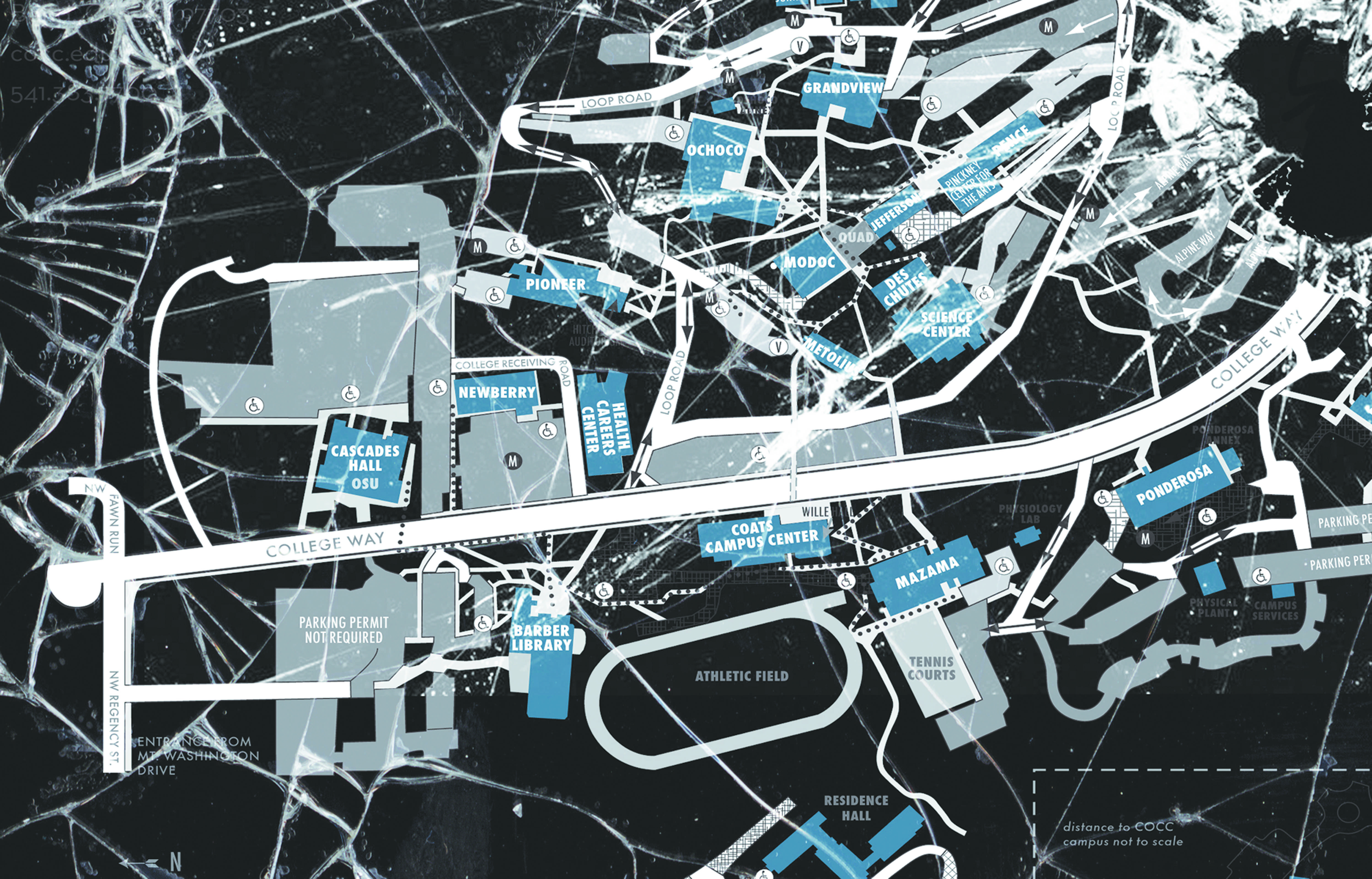As Students, Central Oregon Community College endorses a run, hide, or fight program according to Gordon Price, director of student of life. Campus Public Safety (CPS) will be offering classes to students and faculty in the near future regarding run, hide, fight, according to Jim Bennett, director of CPS.
“If you’re a student in that situation, you have to take care of yourself,” Price said.
Below is the active assailant situation guide courtesy of campus public safety.
Active Assailant Situations
COCC will continue to work with local law enforcement agencies to ensure the most appropriate contingency planning for any potentially high threat dangers due to an assailant on campus. However, COCC – like virtually all colleges campuses in this country – is an open campus where there is little control and only general supervision over individuals on campus. The following information is intended to provide faculty and staff with general actions to be followed in the event of any such high threat incident. Faculty and staff are encouraged to review the document, keep a copy as a periodic reminder and carefully read future updates.
An active assailant is a person(s) who is attempting to harm or kill people in a populated area. In most cases, assailants use firearm(s) and have no pattern or method to their selection of victims. These situations are dynamic and evolve rapidly, demanding immediate steps to mitigate harm to potential victims.
General Guidance to Faculty, Staff and Students
In general, response to an active assailant will be dictated by the specific circumstances of the encounter. Try to remain calm and use these guidelines to help plan a strategy for survival. If you witness an armed individual on campus at any time:
- Immediately call the police by dialing 911 (9-911 from a campus phone)
- As soon as possible, call Campus Public Safety at 541-383-7272 (7272 from a campus phone)
In an assailant situation, the Campus Public Safety Office will take charge of providing specific direction in relationship to the situation until Emergency Services arrive.
Prepare in Advance
Prepare a plan of action in advance by determining your escape route(s) and know where to evacuate to (see the Evacuation section of this booklet for Campus Evacuation sites). Discuss your plan with co-workers in your area. Refer questions to the Campus Public Safety office at 541-383-7272.
If the Active Assailant Is OUTSIDE Your Building:
- Turn off all the lights, close the blinds, and close and lock all windows and doors.
- Move to an area in the building away from windows or where the assailant cannot see you from the exterior of the building. If safe to do so, remain there until an “all clear” instruction is given by an authorized, known voice. If you do not recognize the voice, do not change your location and remain where you are. Unknown or unfamiliar voices may be the assailant.
- If you can do so safely, get everyone around you on the floor and out of the line of fire.
If the Active Assailant Is INSIDE Your Building:
- If it is possible to flee the area safely and avoid danger, do so.
- As soon as it is safe, call the police by dialing 911 (9-911 from a campus phone) and Campus Public Safety at 541-383-7272 (7272 from a campus phone), Mon-Fri, 8 a.m. to 4:30 p.m.
- If it is unsafe to flee your building, lock all doors to secure yourself in a safe space; if you can do so safely, get everyone on the floor and out of the line of fire. Remain silent. If safe to do so, remain there until an “all clear” instruction is given by an authorized, known voice. If you do not recognize the voice, do not change your location and remain where you are. Unknown or unfamiliar voices may be the assailant.
If the Active Assailant is in Your Immediate Area/ OR Confronting You:
- Use your best judgment. If hiding or flight is impossible, consider attempting to negotiate with the individual. Trying to overtake the assailant is a last resort that should only be initiated in the most extreme circumstances.
- Remember, there may be more than one active assailant.
- In case you must flee, do not go to the normal gathering site for your building. Get as far away from the scene as possible and then contact authorities. Do not attempt to remove injured people as you may injure them further; instead, leave victims where they are and notify authorities of their location as soon as possible.
If You Find Yourself in an Unsecured OR Open Area Such as a Parking Lot:
- Immediately seek protection and put something between you and the assailant. Evaluate your options. Do you know where the assailant is? Is escape your best option? Is escape immediately available? If you decide to flee, run in an erratic pattern such as “zig-zagging”.
- Contact 911 once you have reached an area of safety away from the assailant.
In ALL Cases:
- To assist police, stay calm and patient to prevent any interference with police operations. If you know where the suspect is, or have his or her description, tell the police. Rescue teams will follow shortly to aid you and the others.
- Do not to make any changes to the incident scene as law enforcement authorities will be conducting a criminal investigation later.
- If you encounter police officers, keep your hands empty and in plain view at all times. Do not speak to the officers until they speak to you. Listen to their instructions and do exactly what they say. If you are evacuating, carry nothing that could be mistaken for a weapon.

What is COCC doing?
The college has very clear procedures to follow in the event of an active assailant, according to Bennett, the assistant director of Campus Public Safety (CPS). As soon as CPS is aware of a shooter on campus, measures are taken to notify students and staff via the emergency notification system (ENS). Bennett emphasizes the importance of signing up to receive notifications, as ENS is an opt-in program. Once a someone has opted in, he or she will receive up-to-date notifications regarding emergencies or campus closures on his or her mobile device.
“From the moment we get a call we are working with local emergency responders,” Bennett said.
Because campus safety officers are unarmed, they are unable to actively engage shooters. Despite this, they play a very important role in such an emergency, according to Bennett. They are capable and responsible for protecting anyone outside the immediate area of danger. This includes, but is not limited to, evacuating buildings, informing students and locking down facilities.
Once local law enforcement arrives, it is CPS’s job to monitor the situation and provide as much relevant information as possible. The interface between local law enforcement and CPS allows law enforcement to go exactly where they need to be without any wasted time, according to Bennett.
“In many ways CPS is the advanced eyes and ears,” added Matt McCoy, vice president of administration.
CPS officers are extremely capable of handling such a situation, according to Bennett. They receive 480 hours of training prior to becoming an officer, and must have at least 40 hours of continued education every year after that.
“We have a great team and they are well prepared and able to handle incredible things that happen on campus,” Bennett said.
Currently, CPS is reminding staff of emergency procedures. Discussion regarding such procedures are happening all over campus between faculty and students, according to Bennett. CPS plans to offer a class on the concept of Run. Hide. Fight.
Tim Cachelin | The Broadside
(Contact: [email protected])








